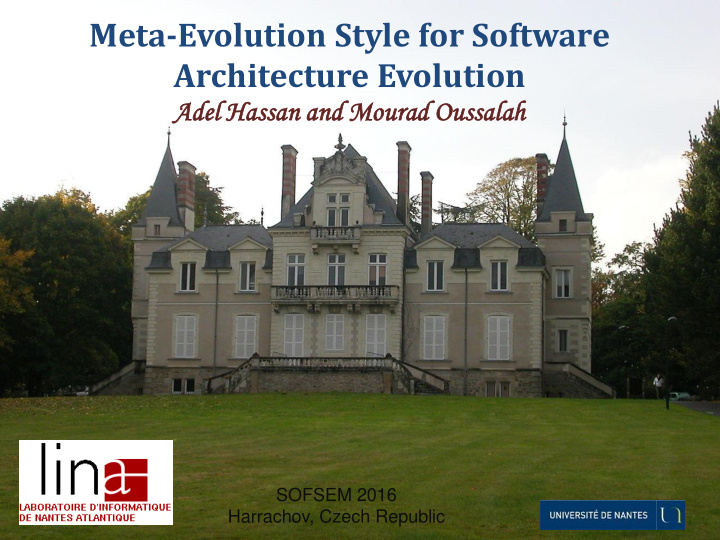



Meta-Evolution Style for Software Architecture Evolution lah Ad Adel Ha Hassan n and Mourad d Oussalah SOFSEM 2016 1 Harrachov, Czech Republic
Outline Motivation Preliminaries Evolution styles Meta-evolution style Conclusion Future Work 2 SOFSEM 2016
Motivation Different techniques (evolution styles) to model software architecture evolution process Mapping, Comparing, Reuse and Interchange modeling concepts among evolution styles. 3 SOFSEM 2016
Preliminaries Change is a recurrent fact of life Software systems have to change to accommodate the new requirements of Markets and Technologies Software architecture is subject to change, like any other software artifacts. to keep abreast or to plan the system change. 4 SOFSEM 2016
Preliminaries Architecture-centric evolution elucidates the reason behind design decisions permits system restructuring at a high level Explore and compare different scenarios Process Modeling aims to capture standardized concepts to model processes for better understanding, management, improvements and ….. 5 SOFSEM 2016
Preliminaries Can we model the potential architecture evolution scenarios in a particular domain To support architects in conducting future evolution Analysis Tradeoff among these scenarios 6 SOFSEM 2016
Evolution styles provides the vocabulary of concepts necessary for modeling architecture evolution activities to model the potential scenarios in evolving a domain-specific software architecture. These scenarios grouped together to be an evolution style Select optimum scenario fit situation at hand 7 SOFSEM 2016
Evolution styles Garlan et al. evolution style 8 SOFSEM 2016
Evolution styles Oussalah et al. evolution Cuesta et al. evolution style. style. 9 SOFSEM 2016
Meta-evolution style MES Each style has specific vocabulary and mechanism and To compare, interchange and reuse the best practices we need to unify the concepts Meta-modeling technique is used to define a meta- evolution style MES Aim to express the different styles 10 SOFSEM 2016
Meta-evolution style MES MES and construction view of evolution style 11 SOFSEM 2016
Meta-evolution style MES MES is a component-oriented concept for modeling the software architecture evolution process 12 SOFSEM 2016
Meta-evolution style MES Vertical mapping 13 SOFSEM 2016
Meta-evolution style MES Mapping MES to MOF Horizontal mapping To map with MOF compatible models (e.i. UML, SPEM ) the OMG UML Profile for MOF specification defines rules to transform a MOF model into a UML model 14 SOFSEM 2016
Meta-evolution style MES SPEM Software Process Engineering Metamodel SPEM is defined as a UML profile Garlan et al. style SPEM metamodel Operator, Transition Activity Architect Role Evaluation Function Guidance Constraint Responsibility, Relationship, Guidance Evolution State Work Product Garlan style and SPEM: corresponding elements 15 SOFSEM 2016
Conclusion MES’s concepts conformed by different styles Using the transferring rules enacted by MES It is easy to translate an evolution style to Other evolution style MOF compatible modeling language (SPEP/UML, EPFC) 16 SOFSEM 2016
Future Work Develop a framework based on MES allow to exploit, reuse and extend styles to build a library contain a variety of evolution styles Explore the meta-evolution style with dynamism 17 SOFSEM 2016
18 SOFSEM 2016
Recommend
More recommend